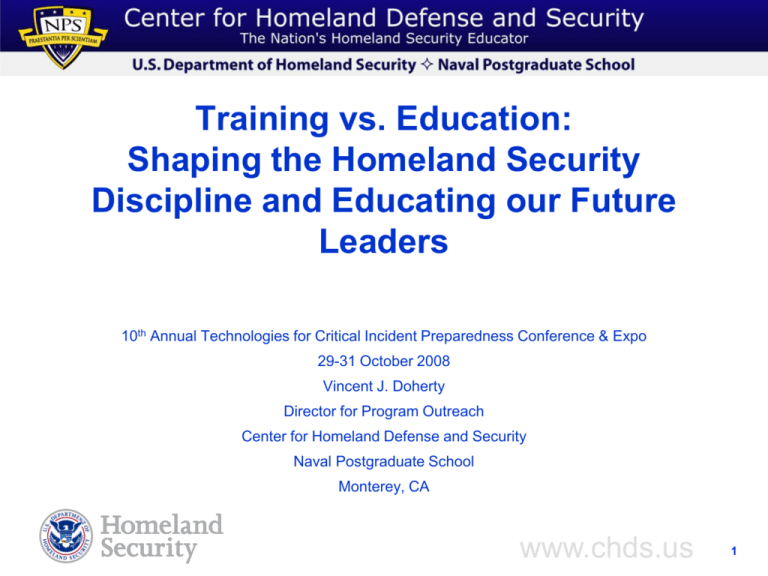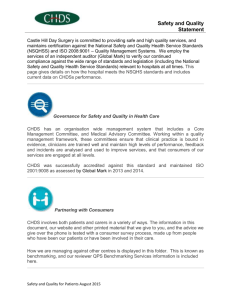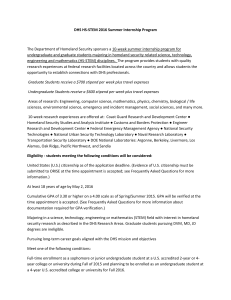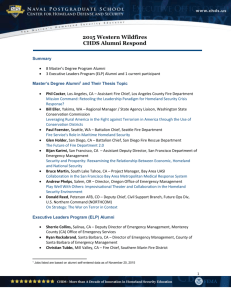Training vs. Education: Shaping the Homeland Security
advertisement

Training vs. Education: Shaping the Homeland Security Discipline and Educating our Future Leaders 10th Annual Technologies for Critical Incident Preparedness Conference & Expo 29-31 October 2008 Vincent J. Doherty Director for Program Outreach Center for Homeland Defense and Security Naval Postgraduate School Monterey, CA www.chds.us 1 Who am I? www.chds.us 2 Education: a definition Education is: the development of the mind and intellect. encompasses teaching and learning of the fundamental aspects of a culture from one generation to another The imparting of knowledge, positive judgement and well developed wisdom It means 'to draw out', facilitating realization of self-potential and latent talents of an individual It is a personal activity which enhances the ability to use the mind for personnel pleasure or gain. It is using language to develop knew knowledge and inquire about your environment www.chds.us 3 Training: a definition Training is: the learning of specific skills The acquisition of knowledge, skills and competencies Has specific goals of improving one’s capability capacity and performance The developed skills are used more for social or economic reasons then for self improvement ‘This implies that education comes first’ www.chds.us 4 Where do we train? Formal - training ground, classroom, conferences, consortiums Informal – apparatus floor, fire ground, field Where do we educate? Formal – class rooms, conferences, universities Informal Kitchen table, precinct house www.chds.us 5 Issues in Homeland Security Do we train or educate our Emergency responders? Where do we invest on our people? How do we make that investment? www.chds.us 6 Training Issues in WMD Response Office of State and Local Domestic Preparedness Support, (OSLDPS), 1998 commissioned a study The ODP Training Strategy of 2001 Researchers confirmed People remember 90% of what they do 75% of what they say 10% of what they hear www.chds.us 7 Training Issues in the ODP Strategy Who should be trained? What tasks should they be trained to perform? Which training instruction/delivery methods and training sites should be paired with which tasks to maximize success in training? What methods are most capable of evaluating competency and performance upon completion of training? What gaps need to be remedied in existing training to assure consistency with the findings of The Training Strategy? www.chds.us 8 Education issues Do we educate our people? Are we as a discipline capable of educating our people? -or- Should we leave that up to our schools and universities? www.chds.us 9 Argument We do a great job in training our people -but- We do a poor job in educating or leaders www.chds.us 10 Why Educate? Get that piece of paper! Respect for our opinions! Critical thinking! Leadership! www.chds.us 11 GRADUATE EDUCATION for HOMELAND DEFENSE AND SECURITY Background HS was non-existent as a discipline before 2001 and will continue to evolve for decades 2001 government study identified gaps in education that prepares officials to undertake new HS roles and responsibilities www.chds.us 13 CHDS Purpose CHDS established in 2002 to: Provide a neutral educational forum for leaders to come together in an intergovernmental multi-disciplinary group to discuss and debate HS Develop programs that are heavily evaluated to ensure local, state, tribal and federal leaders drive educational offerings and evolution of content Create “multiplier effect” to maximize federal investment – share program content, research and resources with organizations across the nation to build national preparedness through education www.chds.us 14 Master’s Degree Program Students are current and “fast rising” local, state, tribal and federal leaders from all HS disciplines; integration of leaders in classroom mirrors HS across nation “One of a kind” learning atmosphere Breaks down stovepipes Builds lasting national culture & professional networks 143 students enrolled; 5 simultaneous cohorts (3 in Monterey, CA and 2 in the National Capital Region) DHS officials participate as part of DHS Homeland Security Academy More than 235 alumni; graduating 3 cohorts per year Students in-residence two weeks each Academic Quarter during 18month program (total of 12 weeks) Remainder of coursework completed via cutting edge distance learning www.chds.us 15 MA Curriculum Content Introduction to Homeland Security Technology Management for HD/S Unconventional Threat in HS Special Topics in HS (WMD, Agroterrorism, Financing of Terrorism, Public Health, Borders and Immigration, etc) Critical Infrastructure – Vulnerability Analysis and Protection Risk Communication – Psychology of Terrorism and Fear Management (Stanford) Intelligence for HD/S: Organizational and Policy Challenges Homeland Defense and Security: An Interdisciplinary Approach (Public Health, Law Enforcement, Defense, Fire, etc) Strategic Planning and Budgeting for HD/S Policy Analysis and Research Methods Comparative Government: HS Policy Implications for the U.S. Knowledge into Practice: A Homeland Security Capstone Course www.chds.us 16 Master of Arts in Security Studies: Homeland Security and Defense The average student profile The location The schedule The format The application The thesis The cost The outcome www.chds.us 17 Statistics As of Fall 2008: 378 Total students enrolled: 143 Total Alumni Graduated: 235 Leading States: CA (38), NY (33), FL (15), WA (14) www.chds.us 18 Statistics: Disciplines State & Locals: 62.7% Federal: 18.8% Military: 18.8% Law Enforcement: 22.8% Fire/EMS: 14.8% Emergency Management: 12.2% Public Health: 7.1% Health Care: 0.5% www.chds.us 19 MA Student Research Research papers and theses on actual policy development issues confronting local, state, tribal and federal government; many theses are being implemented around the country and are cited as “best practices” MA thesis provides student Sponsors with a “twofer” Low-cost, high quality research completed on priority Sponsor topics (many graduates implement their thesis) Creates national Subject Matter Experts www.chds.us 20 HS Research: Thesis Impact “Radio Interoperability: Addressing the Real Reasons We Don't Communicate Well During Emergencies,” (Ronald Timmons) “Homeland Security and Capabilities-Based Planning: Improving National Preparedness,” the Netherlands is adopting approach and asked author to visit and advise them (Sharon Caudle) “Interagency Collaboration Challenges Among Homeland Security Disciplines in Urban Areas,” (Jay Hagen) “Enhancing Homeland Security Efforts by Building Stronger Relationships between the Muslim Community and Local Law Enforcement,” St. Paul, MN granted $250,000 to implement policy (Dennis Jensen) “A Case Study of Intelligence Infrastructure Created by Executive Order,” led to Cabinet/Gov-level reorganization in state of Utah; creation of Utah Criminal Intelligence Center (Bob Flowers) “U.S. Coast Guard Reorganization: Why Merging the Field Units is Not Enough to Remain Semper Paratus (Always Ready),” assisted creation of USCG Field Intelligence Support Teams (Larry Green) “Implementing Maritime Domain Awareness,” implemented as MDA Policy in USN and USCG; used as basis of National Maritime Security Strategy (Robert Watts) www.chds.us 21 Alumni Alumni of the Master’s and Executive Leaders Programs are leaders responsible for the policies, strategies and organizations that constitute our nation’s HS system Alumni Association is a national “think tank” supporting the development and revision of HS policies and strategies as well the expansion of the HS knowledge base through on-going research, discussion and debate Distinguished Graduate Fellowship - Provides selected Fellows opportunity to serve at DHS for one year; DHS benefits from broad state and local perspectives that Fellows represent; state and local governments benefit from national perspective and DHS programmatic knowledge that Fellows bring back to their agencies www.chds.us 22 Dystopia Virtual City A comprehensive virtual urban environment for Homeland Defense & Security studies, training, and exercises Two urban areas separated by a state border Major port facilities International airport Major military installation Universities and schools Power, water, telecom, transportation infrastructure www.chds.us 23 CHDS Programs Core Programs Multiplier Effect Programs Master’s Degree Program University & Agency Partnerships Executive Leaders Homeland Security Affairs Journal Program Executive Education Seminars State/Governor METs Urban Areas METs Topic specific seminars HS Digital Library Alumni Association “Think Tank” Distinguished Graduate Fellowship On-line Courses Applied Research Publications National Guard Graduate Certificate Program www.chds.us 24 Online Courses Goal: Provide education on HD/S Strategy, Policy and Planning to thousands of HD/S professionals Online Courses – non-credit versions of MA courses to enhance understanding of key concepts; offers flexibility of self-paced instruction – newest course “The Global Jihadi Threat” Certificate Program in Prevention: On-line courses to educate state, local and private sector planners to meet emerging planning & capability standards Tied to & supportive of related DHS initiatives & policy guidance Leverages existing NPS curriculum, HS library, & scenario-based learning system Lead Partner: Center for Rural Development, Somerset, KY www.chds.us 25 Executive Education Program Mobile Education Team (MET) Seminars Half-day, graduate-level seminars for Governors, Mayors and senior staff Provides neutral educational forum to discuss and debate HS challenges National Reach - more than 100 sessions - spanning country from Pacific territories to Puerto Rico State METs for Governors and their Cabinets Urban Area METs Topical Seminars More than 2,800 elected and senior leaders have participated Seminars clarify new state and local roles and non-traditional responsibilities Assists senior officials to recognize specialized requirements of prevention, protection, and response and recovery to catastrophic events, and to discuss related policies, strategies and organizational structures www.chds.us 26 Executive Leaders Program Four one-week seminars over nine months for most senior level officials Combines MA & MET curriculum on topics around four mission areas of preparedness: Prevention, Protection, Response, Recovery Provides an educational forum to enhance senior leaders’ capacity to identify and resolve HS problems Participants acquire a deeper understanding of current and emerging HS issues, public policy debates, and terrorist threats as well as evolving smart practices Broadens leaders' perspectives with a vision for addressing HS in innovative ways and strengthening working relationships across regions, agencies, and jurisdictional lines Two cohorts per year; DHS leaders participate as part of DHS University System www.chds.us 27 HS Digital Library – www.hsdl.org “Securing the Homeland through the Power of Information” Mission – Nation’s premier repository of HS policy related documents Organized to support HS local, state, tribal and federal official decisionmaking and analysis Structured to assist scholars and academics in graduate level HS research Multi-discipline holdings (continuously updated): All critical policy documents related to HD/S, including Presidential Directives, National Strategies and DHS policies Users nationwide – 20,000 visits per month Federal, State, Local and Tribal agencies (NYPD, etc.) DHS Centers of Excellence and 400 academic institutions –Stanford, UConn, Yale, NYU, NDU, Boston U., Texas A&M Executive Office of the President, Congressional staff, CRS and GAO www.chds.us 28 Homeland Security Affairs Journal Academic, On-line journal (www.hsaj.org) published quarterly Peer-reviewed journal providing a forum to propose and debate strategies, policies and organizational arrangements to strengthen HS Nationally-read and disseminated articles (7,700 visitors/month), written by CHDS alumni, students, faculty and subject matter experts and scholars across the country www.chds.us 29 National Guard Graduate Certificate Program Develop cadre of educated NG personnel to enhance state and federal HS/HD and emergency management operations Build organizational arrangements needed to strengthen HS, including local/state/federal, civil-military and interagency cooperation Raise the level of education across the NG Leverage DHS investment in HS graduate education by using CHDS programs as basis and “force multiplier” One year, 12 credit hour graduate level certificate in HS/HD and Defense Support to Civil Authorities Use CHDS University Partners and CHDS alumni to co-teach in every state and territory Content, developed by NPS and NG, primarily derived from DHS vetted Master’s Curriculum Hybrid Format - Short in residence followed by Distance Learning Program open to local, state, tribal and federal officials around the country www.chds.us 30 University & Agency Partnership Initiative (UAPI) Helps other Universities build their own HS education programs Vastly increases number of students receiving HS education and accelerates establishment of high-quality programs Nationwide beyond NPS campus Avoids “re-inventing the wheel” by leveraging taxpayers’ investment at NPS; reduces expense and difficulty of other Universities to build their own curricula from scratch Provides Universities, Colleges and Agencies: Course syllabi, web-enabled course components (audio, text, video), e-readings, distance learning web-platform Moodle (agencies also use Moodle for information sharing), etc. “Teach-the-Teacher” knowledge transfer and collaboration; seminars held at NPS Access to HS Digital Library In return, partner Universities share their curriculum and specialized expertise with NPS and other Partnership participants UConn is NPS’ “proof of concept;” MA curriculum launched September 2005; dozens of other Universities are conducting similar collaborative efforts with NPS Co-sponsor annual HS Education Summit; more than 100 Universities and 200 officials and academics participate www.chds.us 31 Lest We Forget, NEVER! www.chds.us 32 www.chds.us 33 www.chds.us 34 Questions? Vincent J. Doherty Director for Program Outreach Center for Homeland Defense and Security Naval Postgraduate School vjdty@aol.com 516-582-2517 (CELL) www.chds.us 35 Introduction: Leadership is… Leadership is influencing people by providing purpose, direction, and motivation, while operating to accomplish the mission, taking care of people, and improving the organization. - Anonymous From a presentation on Leadership by Dean Robert L. Ord, III, 9 October 2007 School of International Graduate Studies Global Center for Security Cooperation www.chds.us 36 What Makes a Leader Being a person of character is fundamental. Everyone is part of a team, and all members have responsibilities that go with belonging to that team. Everyone is important to the success of the team. www.chds.us 37 Principles of Leadership Know yourself and seek self-improvement. Be technically and tactically proficient. Seek responsibility and take responsibility for your actions. Make sound and timely decisions. Set the example. Know your subordinates and look out for their well-being. www.chds.us 38 Leadership (Con’t) Keep your subordinates informed. Develop a sense of responsibility in your subordinates. Ensure the task is understood, supervised and accomplished. Build the team. Employ your organization in accordance with its capabilities. www.chds.us 39 What is Expected of Us as Leaders When in charge, take charge. When in doubt, do what is right. Make things happen the way they are supposed to happen. Accomplish the mission with what you’ve been given or what you can create. www.chds.us 40 What is Expected of Us as Leaders (con’t) When things go wrong, assess the situation, choose the best course of action and act. Know the team members, their strengths and weaknesses, and act accordingly. Take care of the team members and their families. Generate enthusiasm. www.chds.us 41 Can we train our Leaders? -orAre we obliged to educate our future leaders? www.chds.us 42







